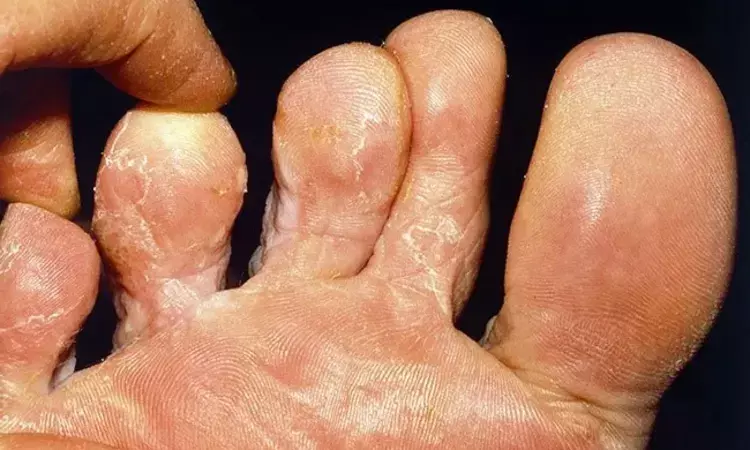- Home
- Medical news & Guidelines
- Anesthesiology
- Cardiology and CTVS
- Critical Care
- Dentistry
- Dermatology
- Diabetes and Endocrinology
- ENT
- Gastroenterology
- Medicine
- Nephrology
- Neurology
- Obstretics-Gynaecology
- Oncology
- Ophthalmology
- Orthopaedics
- Pediatrics-Neonatology
- Psychiatry
- Pulmonology
- Radiology
- Surgery
- Urology
- Laboratory Medicine
- Diet
- Nursing
- Paramedical
- Physiotherapy
- Health news
- Fact Check
- Bone Health Fact Check
- Brain Health Fact Check
- Cancer Related Fact Check
- Child Care Fact Check
- Dental and oral health fact check
- Diabetes and metabolic health fact check
- Diet and Nutrition Fact Check
- Eye and ENT Care Fact Check
- Fitness fact check
- Gut health fact check
- Heart health fact check
- Kidney health fact check
- Medical education fact check
- Men's health fact check
- Respiratory fact check
- Skin and hair care fact check
- Vaccine and Immunization fact check
- Women's health fact check
- AYUSH
- State News
- Andaman and Nicobar Islands
- Andhra Pradesh
- Arunachal Pradesh
- Assam
- Bihar
- Chandigarh
- Chattisgarh
- Dadra and Nagar Haveli
- Daman and Diu
- Delhi
- Goa
- Gujarat
- Haryana
- Himachal Pradesh
- Jammu & Kashmir
- Jharkhand
- Karnataka
- Kerala
- Ladakh
- Lakshadweep
- Madhya Pradesh
- Maharashtra
- Manipur
- Meghalaya
- Mizoram
- Nagaland
- Odisha
- Puducherry
- Punjab
- Rajasthan
- Sikkim
- Tamil Nadu
- Telangana
- Tripura
- Uttar Pradesh
- Uttrakhand
- West Bengal
- Medical Education
- Industry
Soaking socks in QAC-based detergent effectively reduces risk of reinfection in tinea pedis

Denmark: High rates of reinfection and the emergence of terbinafine-resistant strains of Trichophyton spp complicate the treatment of tinea pedis and onychomycosis. An important measure is the effective disinfection of contaminated socks. The risk of reinfection can be reduced by appropriate washing and is paramount for the treatment of tinea pedis and onychomycosis.
A recent study, published in the journal Mycoses, has found that soaking in a QAC-detergent for 24 h is effective in disinfecting sock pieces contaminated with dermatophytes.
The study was conducted by Ditte Marie Lindhardt Saunte, Department of Dermatology, Zealand University Hospital, Roskilde, Denmark, and colleagues with the objective to describe the effect of commonplace disinfection methods using socks pieces inoculated with terbinafine-resistant or terbinafine-susceptible isolates of Trichophyton spp.
For this purpose, sock pieces were inoculated with seven terbinafine-resistant isolates of Trichophyton spp. with known mutations in the SQLE-gene (T. rubrum (n = 3), T. interdigitale (n = 1) and T. indotineae (n = 3)) and six terbinafine-susceptible isolates of Trichophyton spp. (T. rubrum (n = 3) and T. interdigitale (n = 3)).
Disinfection methods included soaking in a quaternary ammonium (QAC) detergent (0.5, 2, and 24 h), freezing at −20°C (0.5, 12, and 24 h), domestic and steam washing (both at 40°C with detergent). Following disinfection, sock pieces were cultured for 4 weeks. No growth at the end of week 4 was the primary endpoint.
Key findings of the study are as follows:
- Soaking in a QAC-detergent for 24 h procured at disinfectant rate of 100%, whilst soaking in 0.5 and 2 h had a disinfectant rate of 46.2% and 84.6%, respectively.
- Domestic washing (40°C with detergent) produced a disinfectant rate of 7.7%.
- Freezing at −20°C (0.5, 12 and 24 h) and steam washing (40°C with detergent) had no disinfectant properties.
The researchers wrote in their conclusion, "patients should be advised to either launder their socks at a minimum of 60°C21, 22 or soak their socks in a QAC-based detergent for at least 24 h prior to laundering to effectively reduce the risk of reinfection."
The results of the study indicate that laundering at 40°C with domestic detergent, steam washing at 40°C with domestic detergent and freezing at −20°C all are not effective for disinfection of contaminated fabrics. The need for evidence-based recommendations is emphasized by high rate of reinfection from tinea pedis and onychomycosis.
"Considering the current epidemic of terbinafine-resistant infections, this has become even more important as effective disinfection of textiles may contribute to a lower reinfection and transmission rate," the authors wrote in their study.
Reference:
Skaastrup KN, Astvad KMT, Arendrup MC, Jemec GBE, Saunte DML. Disinfection trials with terbinafine-susceptible and terbinafine-resistant dermatophytes. Mycoses. 2022 Jul;65(7):741-746. doi: 10.1111/myc.13468. PMID: 35535729.
Dr Kamal Kant Kohli-MBBS, DTCD- a chest specialist with more than 30 years of practice and a flair for writing clinical articles, Dr Kamal Kant Kohli joined Medical Dialogues as a Chief Editor of Medical News. Besides writing articles, as an editor, he proofreads and verifies all the medical content published on Medical Dialogues including those coming from journals, studies,medical conferences,guidelines etc. Email: drkohli@medicaldialogues.in. Contact no. 011-43720751


